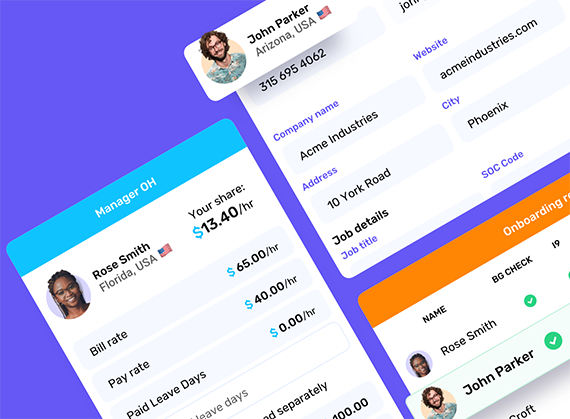By this point, you are likely aware of the many dangers involved in misclassifying should-be W-2 employees as 1099 independent contractors (IC’s).
While this has always been a questionable business practice, the “Misclassification Initiative,” began in 2011 by the Internal Revenue Service (IRS) in partnership with the U.S. Department of Labor (USDOL), has made costly consequences even more likely. Companies that misclassify run the increasing risk of an audit that could result in large fines, back wages, and back taxes owed. And now, employers who attempt to skirt the employer healthcare mandate of the Affordable Care Act (ACA) by misclassifying workers will be hit with additional fines. This has forced many organizations to explore switching from a 1099 employment model to a W2 model. We explore that further in this free white paper.
Additional risks
However, government watchdog agencies are not the only dangers these companies face. They also invite lawsuits by former independent contractors who contend they were rightly employees. The cautionary tale of FedEx Corp. is all over the news due to the recent announcement of a $228 million payout to settle independent contractor litigation in the United States District Court for the Northern District of California.
In 2014, the Ninth Circuit Court of Appeals ruled that “FedEx Ground, a subsidiary of FedEx Corp., misclassified a class of 2,300 drivers as independent contractors instead of employees,” according to Staffing Industry Analysts. Following that event, FedEx announced that it “disagreed with the ruling” and sought a review of the decision over the past year. However, the June 12, 2015 announcement of the settlement indicates that the decision was upheld.
Misclassification: a long shadow
Even though FedEx changed their controversial policy in 2011 (they now contract with incorporated businesses that treat the drivers as W-2 employees), they are still paying for their past mistakes. They have lost lawsuits filed by former contractors in numerous states, but the $228 million settlement with a group of former California drivers is a massive financial hit. The lead counselor for the group called the settlement “the largest in recent memory,” and noted the comparison to the total amount collected by the USDOL in all of its 2013 employment cases—$264 million.
As Staffing Industry Analysts pointed out, the California case is only one of the “28 cases in multi-state litigation against FedEx” over the misclassification issue. While many of the other cases are yet to be decided, it is clear that, at best, FedEx will be in court for years to come.
How worker classification is determined
The IRS looks at a number of factors to determine if a worker should be an IC or a W-2 employee for tax purposes. Those factors fall into three main categories under common law that are considered to determine the degree of control and independence in the work relationship:
- Behavioral control: If the company provides training and instructions about when, where, and how to do the work, they have maintained the right to control, so the worker is likely a W-2 employee.
- Financial control: A company may be shown to exercise financial control if they reimburse expenses, provide tools and facilities, pay the worker by the hour rather than by the job, and/or if they are the person’s only source of work.
- Type of relationship: Facts showing the tie between the parties, including (1) written contracts, (2) whether the worker receives benefits, (3) the duration of the work, and (4) the extent to which the services are an aspect of the company’s regular operations.
Implications for recruiters
What does all this mean for recruiters and their clients? For one thing, it is yet another reason to be extremely cautious when classifying any worker as a 1099 independent contractor rather than a W-2 employee. For another, it is an urgent reminder to encourage client companies to examine their current classifications and to consider reclassifying ICs as W-2 employees.
If they balk at employing the workers themselves, whether due to the ACA employer mandate or for other reasons, provide the alternative of converting ICs to contractors who are the W-2 employees of a contract staffing back-office service. You can relieve any worries they may have by choosing an ACA-compliant back-office with a strong reputation for financial and legal responsibility.





